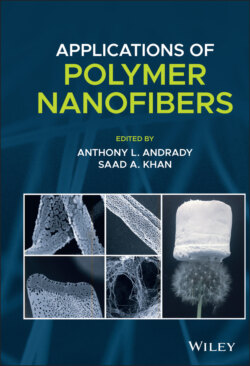Читать книгу Applications of Polymer Nanofibers - Группа авторов - Страница 24
1.6 Advanced Fiber Characteristics 1.6.1 Ribbons, Wrinkles, Branching, and Netting
ОглавлениеElectrospinning generally produces fibers with circular cross sections. However, other morphologies have been observed, e.g. flat ribbons, wrinkled surfaces, and branched fibers (Figure 1.4) (Koombhongse et al. 2001; Huang et al. 2000). The morphology affects the specific surface area as well as the mechanical properties of the resulting fiber mats (Camposeo et al. 2013).
Ribbon structures can have two forms, flat ribbon and a ribbon with two tubular ends (Figure 1.4) (Koombhongse et al. 2001). With the use of a high‐speed camera, Reneker and coworkers determined that this morphology formed prior to deposition. The fibers emerged from the tailor cone with a circular cross section. A thin skin formed on the fiber as the outer layer of the fiber dried and thinned. The solvent inside the skin diffused out rapidly due to the high surface area to volume of the fiber during thinning, and with atmosphere pressures, the skin deforms. The fibers changed from circular to elliptical to either flat ribbons or ribbon with two tubular ends when the fiber skin collapses (Koombhongse et al. 2001). The final shape, i.e. flat ribbon or ribbon with two tubular ends, is dictated by the stiffness of the skin and self‐repulsion charges. Ribbon structures were observed with fibers made with 30 wt% PS in DMF, 10% poly(ether imide) in hexafluoro‐2‐propanol (Koombhongse et al. 2001), and 81 kDa recombinant protein (Huang et al. 2000).
Figure 1.4 Overview of interesting electrospun structures: (A (a–d)) ribbons
(Source: Reprinted from Koombhongse et al. (2001). Copyright (2001). Wiley.),
(B) wrinkled fiber
(Source: Reprinted (adapted) with permission from Pai et al. (2009). Copyright (2009). American Chemical Society.),
(C (a, b)) branched fibers
(Source: Reprinted from Koombhongse et al. (2001). Copyright (2001). Wiley.),
and (D) fiber nets
(Source: Reprinted from Wang et al. (2017). Copyright (2017), with permission from Elsevier.).
Alternatively, when the skin collapses, the fiber surface can wrinkle due to the buckling instability associated with the skin pulling inward as the solvent evaporates. The final shape, i.e. wrinkled fibers or a flat fiber, depends on the ratio of the Young's modulus of the core to that of the shell as well as the ratio of the radius of the fiber to thickness of the shell. The wrinkles are less deep when there are more wrinkles and the cross section is closer to circular. The morphology can also be affected by solvent volatility. Higher volatility tends to result in ribbons, whereas lower volatility tends to lead to wrinkling. For example, polystyrene/tetrahydrofuran (high volatility) formed ribbons, whereas polystyrene/DMF (low volatility) produced wrinkled fibers at the same polymer concentration (Koombhongse et al. 2001; Wang et al. 2009).
Another morphology that can occur in electrospun fibers is branching. Branched fibers are a small fiber splitting from the main fiber, and these splits are often times formed at the bends of the fibers. Similarly, split fibers occur when a primary fiber splits into smaller fibers. This phenomenon is due to jet instability. Nanofiber/net structures have also been reported. Din et al. electrospun a polyvinyl alcohol/H2O/formic acid mixture and observed typical electrospun nanofibers ~200 nm and a 2D‐nanonet of interconnected nanofibrils with average fiber diameter ~25 nm. This morphology was attributed to the formic acid. The authors posit that the ionized formic acid causes excess charge and a number of charged droplets. Charged droplets form thin films in contact with the liquid jet. Upon solvent evaporation and thermal‐induced phase separation (TIPS) in the thin film, the solidification of the polymer‐rich phase results in a Steiner network of 2D nanonet/nanofibrils. The structure affected transport properties through the electrospun membrane as well as the membrane wettability. Similar structures have been observed with polyamide 6, polyacrylic acid, polyurethane, chitosan, and poly(methyl methacrylate) (Wang et al. 2017).
